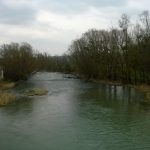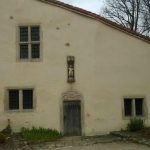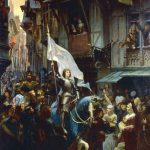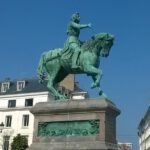FAITH is the basis of all “miracles” and mysteries that cannot be analyzed by the rules of science
– “Think and grow rich”, chapter 3
Introduction
It is the 29 April 1429.
English troops have been besieging Orléans, a city situated on the powerful Loire river in north-central France, for over six months.
The French royal army faces once more its main adversary in a gruesome and convoluted conflict which is smoldering for several decades now (this long period of consecutive military campaigns will later be referred to as Hundred Years’ War1 by historians) and on the whole it seems as if the English crown wins a further important battle of this war.
Despite the desperate military situation for France (or what is left of it at that point – its northern territories had been occupied, and the Duchy of Burgundy is an ally of England), a seventeen year old peasant girl is sailing downstream the Loire river with a small fleet, about to set her foot into the starving city.
Accompanied by her most loyal companions, she wants to join the fierce fighting without hesitation.
And she does. Within a week, the tide has turned.
The royal army of the dauphin Charles (the heir apparent) smashes the siege troops and claims a major and entirely unexpected victory. It will be the turning point of the war.
Visiting North France
France is one of my favorite destinations for holidays and broadening my horizon about history.
I visited Germany’s western neighbor probably more than a dozen times the recent years, especially the south, but the northern and central regions of France as well.
One trip that clearly stood out was a tour from Lorraine in eastern France to the Loire valley area.
Orléans2 (110.000 inhabitants) is located around one hundred kilometers south-west of Paris, the river Loire, which is crossed by five prominent bridges, cutting the city in a northern and a southern part.
The city played a cardinal role in the Hundred Years’ War, where a teenager named Jeanne d’Arc (Joan of Arc) – today worshiped as a national heroine and Sainte Jeanne d’Arc (Saint Joan of Arc) by the Catholic Church – led the French to the decisive victory.
Jeanne d’Arc (Joan of Arc)
Childhood
Jeanne d’Arc was born around the year 1412 into a family of comparatively wealthy craftsmen.
Her birthplace was the small village Domrémy3 in Lorraine, fifty-odd kilometers south-west of Nancy.
She had four siblings, with two of her three brothers belonging to her entourage during the campaigns in 1429 and 1430 (Pierre and Jean d’Arc).
Her education consisted solely of subjects relating to running a farming business, that is: feeding livestock, sowing and harvesting, spinning, and guarding sheep.
Religious Revelations
Jeanne was thirteen years old as she reported her first revelations – it was the same time as Burgundian troops (England’s allies in this devastating war that had been waged for ninety years at this point) raided villages in Lorraine, which bordered immediately on the enemy territory and was therefore an easy target.
The revelations ordered her not to accept her predetermined role as a peasant woman and to refuse marriage.
She was also ordered to keep her maidenhood (virginity) for the rest of her life.
During her whole adolescence she reported about celestial messages and visions (especially from Saint Catherine of Alexandria), giving her the divine mission to lift the siege of Orléans, to expel the English from French territory and to make the dauphin Charles king of France.
Military career of Johanna
At the beginning of 1429 Jeanne headed to Vaucouleurs twenty kilometers northwards of Domremy, where capitaine Robert de Baudricourt, a supporter of the dauphin, was residing.
She told him about her holy mission, and her demeanor was of such confidence and belief that she got send to Charles at Chinon on 12 February 1429, where the firmness of her religious beliefs and her maidenhood were examined.
Well-equipped and obsessed about her mandate she made off to Orléans with her entourage at the end of April, where she gained massive momentum among the demoralized Frenchmen and eventually generated the force to lift the siege on May 8.
Following this outstanding military achievement, the dauphin was crowned on July 17 in the cathedral of Reims, as king Charles VII of France.
It was the zenith of Jeanne’s career in the French royal army. And the story could have ended here.
But the peasant girl wanted more, and marched northwards, towards Paris. She underestimated the strength of the enemy, lost gradually the faith of the soldiers (and the king) in her, but never the belief in herself.
The following excerpt from a French film (1994) depicts the last stages of Jeanne’s military career before she got captured by Burgundian soldiers in May 1430 on her unsuccessful last campaigns.
She was burnt at stake, being nineteen years old, for alleged witchcraft but had made her indelible entry in the history books at least.
My own interpretation
There is nothing more intoxicating than victory, and nothing more dangerous
– Robert Greene
Jeanne d’Arc may serve as proof that one needs no formal education or experience when strong beliefs in one’s capabilities make up for it, and coincidence and circumstances fall into place.
There is no doubt Jeanne d’Arc had a charismatic personality that spellbound the soldiers (the majority of them twice her age) in her entourage.
Without the desolate military situation for Charles, a devastating war for about ninety years, the deep-rooted religious beliefs in the middle ages and a popular prophecy that had announced the arrival of a holy maid there would have been no peasant girl with the chance to get a military command.
The dauphin was open to almost every proposal to resolve the invidious military situation, however preposterous it may have appeared in the first place. And here she was, the perfect means of psychological warfare against the English troops.
But Jeanne’s reckless faith in the inevitable victory caused her eventual downfall. She was burnt at stake in Rouen at age nineteen, after been captured, sold (for a large sum), and condemned to death by a religious court4 .
For me, Jeanne d’Arc is a great inspirational figure.
Regardless of your family background or your formal education, you can achieve stunning successes with a charismatic personality and bold action when you are at the right time at the right place.
But this story is also a cautionary tale. Bold acting must be guided by reason and pragmatism, careful planning and – if one thinks in bigger terms – a large-scale strategy.
Something you cannot necessarily expect from an eighteen year old girl who had just accomplished one of the most stupendous military feats in recorded history.
Footnotes
1 the war lasted 116 years (from 1337 to 1453), more precisely
2 for readers who are interested in sightseeing: during a stay in the city I can highly recommend visiting the Cathédrale Sainte-Croix (Orléans Cathedral), the Musée des Beaux-Arts (museum of the fine arts) and the Maison de Jeanne d’Arc (house of Joan of Arc)
3 to honor Jeanne, the town bears the name Domrémy-la-Pucelle today – la pucelle is the French phrase for “virgin” or “maid”
4 a retrial thirty years later proved the injustice of the verdict, and Jeanne was canonized in the 20th century by Pope Benedict XV
References
- Domremy-la-Pucelle – Histoire et patrimoine; ISBN 978-2-86088-087-9
- The 48 Laws of Power – Robert Greene, Profile Books Ltd 1998; ISBN 978-1-86197-278-1





